—
Thanks everyone for being here. And thank you Shelly Rosenblum and the Belkin Gallery for inviting me.
I’ve only been full time faculty here for 18 months or so. And one thing I didn’t know to anticipate were these cross-disciplinary conversations that were possible on-campus. Last week I enjoyed listening to novelist Camilla Gibb talk at the Peter Wall Institute about empathy and anthropology. Today I get to talk with UBC History professor Carla Nappi about Ai Weiwei. This is a great pleasure.
I’m going to avoid saying anything that might be mistaken for art criticism today. It’s not my field. What I’m going to do instead is draw on my own practice area – both in journalism and writing novels – and talk about the narrative that these images suggest to me.
I feel encouraged to do this by Ai Weiwei himself, who didn’t really consider this collection of photos to be a work of art in themselves. This will seem counterintuitive, I realize. Ai WeiWei is one of the most recognized contemporary artists in the world today. He curated this selection from 10,000 original pictures and took the time to put them in a particular order. And of course it’s hanging in an art gallery, so it must be art.
But what he actually said about this collection is: “I would not consciously have called it art. It’s just the activities in my life. Becoming more conscious of my life activities, that attitude was more important than producing work.”
The attitude Ai Weiwei was speaking about was the conviction that he was indeed an artist, a belief that everyone who wants to practice in the arts must somehow attain. Not trying to be an artist. Not planning. But being. With these photographs, Ai Weiwei seems to be telling us, he wasn’t making art, he was making himself as an artist, which is never easy.
As a storyteller, I find that very interesting. Narrative comes to life when three elements first combine: (1) character, (2) desire (for concrete or abstract outcomes), and (3) obstacles that prevent the character from merely claiming what is desired. That’s the juice of narrative right there.
And as I look at these photographs, that’s what I find myself seeing. The beginning of a narrative about Ai Weiwei’s movement towards an objective. He may be a superstar now. But these pictures offer a glimpse of Weiwei at his crucial moment of becoming. 25 years old, out of China for the first time, and for the first time also engaged in a fully autonomous way with his own dreams and desires.
So who was this young man, before becoming the famous man?
History is relevant here. Born in 1957 in Beijing, Ai Weiwei arrived just a few months after his father, the well-known poet Ai Quing, had been denounced by authorities, banned from writing or publishing. And the family had been sent to a work camp in Northeast China. The cultural revolution in 1966 arguably made things worse for them. And without dwelling overly on this history, just consider that Ai Weiwei as a nine year old boy saw his father publically and ritually and repeatedly humiliated. He saw posters with his father’s image and defamatory statements. He saw his father force-marched through the streets, chanting confessions to crimes he hadn’t committed, while children threw stones. In a particularly vivid memory, the artist remembers when his father was denounced as a “reactionary novelist” by people who knew nothing about his father’s writing – he was a poet, and had never written a novel – and these people then doused his father’s face in black ink. Since the couldn’t afford soap, his father’s face remained black for many days.
The end of the Cultural Revolution didn’t heal everything either. “After 20 years of injustice,” he said. “We were given only these words: it was a mistake.”
They were back in Beijing however, and more free than ever before. Ai Weiwei joined the Beijing Film Academy in the Set Design department, where he was going to learn how to paint. But almost immediately he began producing work so outrageous to his instructors that they declined even to consider it for grades. Ai Weiwei eventually quit and applied to study abroad in the US.

So that is the young man who arrived in the East Village in 1981, working part time jobs and by his own description, not really having any solid idea what he was doing there. He speaks of just leaving his apartment in the morning and wandering, without direction or agenda.
But he did have a vision of himself as an artist. And so a crucial triangle takes shape: a character, desire, and all the many obstacles that you might imagine for a broke, new immigrant, shortly to be an illegal immigrant, who has this most impossible of dreams.
Luckily for us, he also had a camera with which that narrative beginning might be captured.

Not immediately however. But it seems that around 1985, or 1986, the photos really started to accumulate. This documenting of himself doing the thing he’d dreamed of doing.

Here’s the son of a poet who was forbidden to write for twenty years. Here’s an artist declaring himself to be subject to no such powers.

“I started my own life, in which I was very clear about my own decisions. Before that, I was a student and all the decisions were made by common requirements – you study at school, finish your studies, and then try to become an artist. Then I realized that I am an artist and that it’s my life and that’s the way I choose to live. So I started to take some photos… excited about this new life and this kind of attitude.”
No surprise then that Ai Weiwei developed what you might think of as the proto-selfie. Here he is at the MOMA

Here he is on West Fourth Street, where Ai Weiwei and other Chinese artists would paint the portraits of passersby.

The artist here is in the process not so much of examining himself as gathering the supporting evidence to prove himself, something this shot into the mirror really captures.

That’s Ai Weiwei recording Ai Weiwei in the process of becoming Ai Weiwei.
In the Facebook era, there is a tendency to dismiss this as self-promotion: fatuous and transparent. But here is a man raised on the edge of a northern Chinese desert, exposed for the first time to the possibilities of the individual. I find this mirror shot makes a lot of sense in that context.
Of course, it’s important to understand that he wasn’t an isolated loner as these images might suggest. Selfies run the risk of suggesting total self-absorption. But this doesn’t appear to ahve been the case. In fact, Ai Weiwei seems to have been a social magnet during this time, constantly in touch with people, exploring, listening, exchanging ideas. One imagines the conversations to have been very lively.
Artist and intellectuals:

A film student from Taiwan.

Here’s the well known Chinese poet Bei Dao visiting with Ai Weiwei in 1988.

Bei Dao is the most notable representative of the Misty Poets, a group of Chinese poets who reacted against the restrictions of the Cultural Revolution. Dao would go on later to write a book of essays about his time in New York called Midnight’s Gate which includes a cloaked reference to Ai Weiwei.
In a piece in Artforum, Philip Tinari writes: “Everyone in Bejing knew that his basement apartment on East 7th Street had become an unofficial embassy for the avant-garde in exile.”
As you might expect, in that case, he was friendly with Allen Ginsberg and Harry Smith

Smith was one of the Godfathers of the beat movement, an artist and experimental filmmaker and bohemian mystic. He was also a fanatical collector of paper airplanes, Seminole textiles and Ukrainian Easter eggs. He would have been living with Ginsberg at this time, having run out of money, an arrangement Ginsberg’s doctor eventually put an end to, the story goes, because Smith was giving Ginsberg high blood pressure.

Ai Weiwei met Ginsburg at a poetry reading at St. Marks In-the-Bowery. Ginsberg knew Weiwei’s father and had met him in Beijing. In the New Yorker, Weiwei describes Ginsberg reading his poetry aloud including White Shroud, which Ginsberg wrote for his mother. “I didn’t quite understand it. But he loved reading it.
If there was a kind of narrative bump, or turning point in this material, this collection of photographs, to me it seems to be the Tompkins Square Riot photos of 1988.

As some will remember, New York had a series of riots in 1988 relating to housing and public parks access. Tompkins Park had itself become a squatters camp which then Mayor Koch famously criticized for being filthy before acknowledging he’d never been there. A curfew was imposed. And on August 6 and 7, police tried to clear people out of the park in what was later referred to as a “police riot”.

This is the front of Christodora House, which is on Avenue B on the east side of Tompkins Park. This is kind of ground zero for the whole dispute. Originally part of the American Settlement House Movement, Christodora House was built in 1928 to provide “low-income and immigrant residents food, shelter, education and health services.” It had a pool and a gym, and was sort of like a private rec centre with social housing. It was in financial difficulties by the 40’s and was sold to the city, who seem to have more or less left it for a couple of decades. During the 60’s it was full of squatters and was reportedly the National HQ of Black Panthers as well as serving as a set for porn films. Wiki tells me that both Iggy Pop and Vincent D’Onofrio at one point lived here.
In 1975, the city sold the property for $62,500 and within a decade the developer began to convert the building to condos, which cause further friction in the area. During the Tompkins square riots crowds broke in and trashed the lobby yelling “Die Yuppie Scum”.

Imagine how angry people would have been if they’d known that in another 20 years, 25 years, a 1400 square foot one bedroom in Christodora would run around $2 million.
Later there would be other protests in Washington Square Park Protest 1988, and Ai Weiwei would be there too.
And the following year would be the year of ACT UP AIDS protests.

I think what we’re seeing here is the shaping of a world view, shaping of a sense of skepticism about power. Here’s a young man marked by the cultural revolution, adrift in America, in the process of proving himself to be what his imagination told him he could be… It is probably critical to note that these protests here would have been followed in months by events in Tianamen Square.
Here’s an artist intensely, ferociously engaged I think. Taking stock.
“We were young at the time and soon identified with the values of the free world because of our recent history. We hated totalitarian society very much and longed for the so-called free world. Later, we became more critical of the US when we found out the country didn’t have as much freedom as it claimed.”
Did Ai Weiwei feel hopeless though? One suspects not. Because woven through the difficult images are always people acting, people (like Weiwei, but in their own ways) claiming themselves.
For every act of suppression, and act of expression.

After 1989, although I haven’t counted them, it seems to me the selfies begin to get less frequent. Ai Weiwei is still present in all of these, but we sense the process of self-discovery is now past its beginnings, that something like conclusions or at least convictions are shaping themselves in this young man.
The future beckons.

The Godfather of Beat Generation, Harry Smith dies

Smith had a heart attack in Room 328 of the Hotel Chelsea. He died in the hospital later in the arms of a poet friend who reported that he was “singing as he drifted away”.

I find myself thinking that Ai Weiwei had an ironic glint in his eye as he selected this as the last of the series.
End credits. Cue the violin. The artist has left the building.
“My experience in the US was the most important experience of my life. There I learned about personal freedom, independence, and the relationship between the individual and the state, as well as the power structure of that society – and art, of course, I learned a lot.”
I want to return to the poet Bei Dao for a moment to close.
This is a short excerpt from Bei Dao’ book Midnight’s Gate about his time in New York. Note that he does not name the artist friend that he meets, but you be the judge who he’s talking about…
“The first time I visited New York was in the summer of 1988. We went to the East Village to look for W…
He’d been living illegally in New York for eight years. People have different reactions to living illegally. Some people live as if they’re walking on thin ice, while others take to it like a fish to water. New York remakes people like no other place.
This man who was a good student – a sophomore in film school – had completely transformed himself. His eyes were gloomy, his face fatter, and his ears bigger.
He was now full of New York slang. As he walked down the street all sorts of people walked over to greet him, their faces full of respect. At that time, the East Village was a land of the homeless, drunks, drug dealers and those suffering from AIDS. He would always grunt a response, but would not say much, just pat them on the shoulder, or stroke their bald heads, and miraculously, their enraged, crazy spirits would calm instantly.
I asked him how he made a living, and he said he painted people’s portraits on the street. He then got out his painting tools, hailed a taxi, and dragged us to a section of West Fourth Street, where a number of other Chinese painters were already trying to drum up business. Unfortunately, luck was not with him that evening as he waited two hours with no one even inquiring about prices. When someone suggested he go to Atlantic City for a little gambling, he immediately closed up shop and sailed off.

I’ll let Ai Weiwei have the last word, a quote which I find resonating in each of these photos. It seems to me that if these photos do one thing, taken all together, it is to show Ai Weiwei reaching this conclusion:
“Creativity,” Ai Weiwei wrote in 2008, twenty years after that visit with Bei Dao… “is the power to reject the past, to change the status quo, and to seek new potential. Simply put, aside from using one’s imagination—perhaps more importantly—creativity is the power to act.”
]]>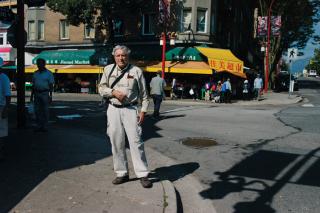
Image: Hubert Kang Canadian Art
First published in Canadian Art Winter 2013
By Timothy Taylor
At 82 years of age, photographer Fred Herzog doesn’t move quite as quickly as he used to. But then, few people ever did. In his younger days, Herzog was the kind of guy who’d jump on his Norton motorcycle after lunch and ride back roads to the top of Mount Baker, 180 kilometres south in Washington state, then motor home in time for supper. “Not always at the speed limit,” he says now, with a sly smile.
When he wasn’t making a literal blur across the landscape—and when he wasn’t working full time as a medical photographer at the University of British Columbia (UBC) or raising his family—he shot pictures on the streets. And rather a lot of pictures, we now know, as a result of a series of high-profile solo shows in Vancouver, Toronto, Ottawa, New York and Berlin over the course of just the past five years. Asked to estimate the total number of pictures he’s taken in his life, Herzog will admit to more than 85,000. Of course, those are only the ones he’s kept.
“I suppose I’m a bit of a workaholic,” he says, with a self-deprecating chuckling and a glint of mischief in his eyes. But then, immediately, he’s back to scanning the world around him. “Here,” he says, voice low. “Let’s look up this alley. There are often things here.”
We’re in Strathcona, Vancouver’s oldest residential neighbourhood, just east of the downtown core…
To continue reading, please
]]>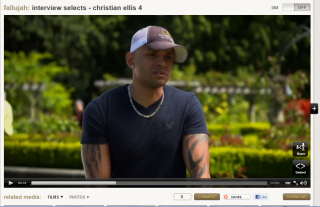
Christian Ellis interview on the Explore.org website
Update: 28 August 2012
The editors at Harpers have assigned the story. So this piece will be appearing in an upcoming issue of that great magazine. We’re very much interested in the story of PTSD and how it is illuminated by Christian Ellis’s story and the remarkable opera inspired by his experiences. That’s both sides of the story: what makes battlefields ever more virulent breed grounds for the types of trauma that induce the syndrome, but also what cultural evolutions in contemporary civilian life contribute to the problem when the vets return home.
It’s a thorny issue. And some recent online posts I made about PTSD prove that feelings are very strong on the topic. It touches more people than I realized. But that only makes the potential for this article greater, and I’m glad to be working on it.
Thanks to Jeremy Keehn at Harpers for the assignment. Great to be working with him again.
—
I had coffee with a fimmaker friend John Bolton recently, who’d been hired to video a remarkable event: the Vancouver City Opera’s full rehearsal of an opera based on the combat and post-war experiences of gay former Marine Seargent Christian Ellis.
The opera, called Fallujah, isn’t remarkable because Ellis is gay or even because he was a Marine. It’s remarkable because, in writing this work, Iraqi/American Heather Raffo and Canadian composer Tobin Stokes (with crucial support of Charles Annenberg and his Explore.org foundation) have done something that nobody has previously. They’ve written a musical work about the Iraq War and what is arguably its most deadly inheritance: Post Trauma Stress Disorder (PTSD).
PTSD is a huge and increasing problem for nations engaged in modern conflict. Read “A Veteran’s Death, A Nation’s Shame“, written by Nicholas Kristoff in the New York times earlier this year, and you may be horrified to learn that there will be a suicide by a veteran every 80 minutes in 2012. Yes, you read that correctly. 25 times the death rate of soldiers in actual conflict.
I mention this story because I’m developing a magazine feature about Ellis. And I’ll say more on that project, hopefully, as weeks go by.
But in the meantime, I wanted to mention how – just after a recent discussion with a friend about Ellis and his story – I found myself sitting at my desk, trying to get my mind back on other assignments, and I had the strangest sensation.
I thought I could hear music.
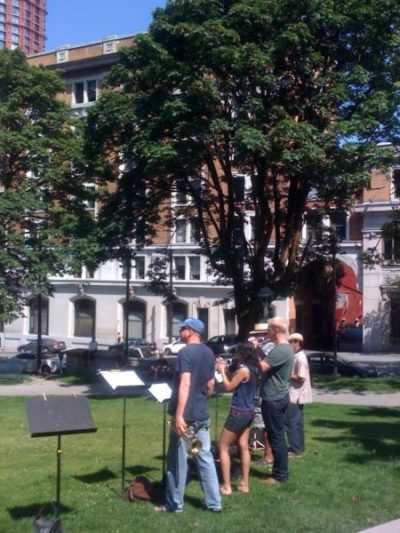
Of course, I laughed at myself, thinking this was a brain image carried over from my conversation, something that Ellis’ story had somehow burned onto my imagination.
After a moment or two however, the auditory reality of what I was hearing could not be denied. Somebody, somewhere, was playing a brassy, orchestral tune, that was dancing along the light Vancouver breeze, from somewhere down on the streets, and was wafting up in strands and disconnected phrases to me, at my computer, in my office overlooking the city.
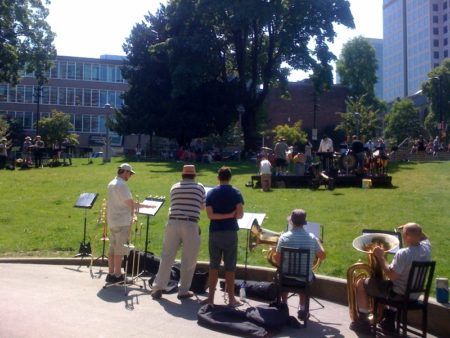
I went downstairs to investigate.
And it turned out: I hadn’t imagined the sound. In Victory Square there were a dozen plus horn players, a couple of percussionists and a conducter. And they were rolling through an improvisational jazz number that I learned later was the work of long time Vancouver jazz player Brad Muirhead.
The piece is called “What’s the Idea?”
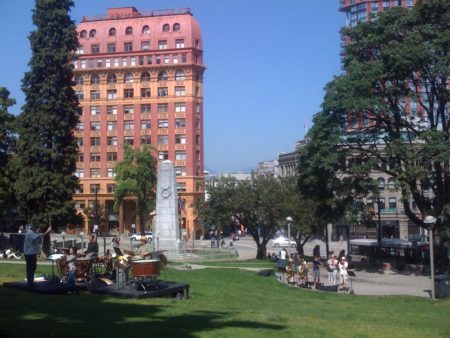
So beautiful. I was glad to be there, glad to be alive.
Thanks Brad Muirhead. And if you want to hear it yourself, the show rolls again Tuesday July 10th at noon, and again on Thursday July 12th at 5pm.
What’s the Idea? Here I’ll go all romantic on you: the idea is music in the city, in the psyche, in the wind, in the heart.
]]>
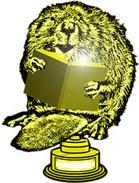
The Golden Beaver
The Blue Light Project has been nominated for a CBC Bookie Award. Thanks to the CBC producers who included me on a list with Patrick deWitt, Esi Edugyen, Brian Francis and Elizabeth Hay. Those are amazing writers! I’m truly honored.
That said, it’s fascinating that this particular novel would be nominated for this particular prize.
The Blue Light Project is the story of a lone street artist, Rabbit, who pulls off a city-scale installation so beautiful that it stops chaos in its tracks. The chaos in question is a hostage crisis. A man storms a TV studio where they’re taping a cynical reality show called Kiddiefame. The man has a bomb. He seals the studio with a bunch of kids inside. The surrounding city descends into bedlam as confusion mounts. The power of Rabbit’s installation is that it umbrellas the city in a moment of intense splendor. But the work also mesmerizes people by magnificently opting out of the intense rivalries that animate shows like Kiddiefame and the broader culture the show reflects.
Rabbit’s art rises above. And dazzled by the vision of it, people are moved and changed.
Obviously, Kiddiefame wasn’t an arbitrary choice. It represent entertainment in our era. What television show isn’t “reality” now? Check out food TV. Five years ago Mario Batalli was sharing recipes. Now he’s battling to the death in Kitchen Stadium. But the whole television product has shifted that way, as television critic John Doyle recently lamented. Everything on the tube now seems to be about people getting chopped and eliminated and dragon-denned into submission.
Literature used to stand aloof from all this mano-a-mano action. At the Giller Prize ceremony with Stanley Park, I recall feeling real sympathy for my fellow nominees. We were all in the same boat, tossed together on the seas of fate. Competition between us was purely abstract since there was nothing we could individually do about anything.
Online voting competitions change that dynamic completely. You can choose not to self-promote (more on that in a minute). But candidates can absolutely influence results. If a vote is your objective, the Tweetiest and most Facebookie candidate can indeed win. Klout = clout.
The Bookies are precisely tuned to the cultural moment, in other words. And their impact will compliment other developments which now extend the writer’s job far past merely writing the book. Post-publication is now the busiest season, where the author needs to be out there working the networks, pumping hands and kissing babies, on the stump, looking for love.
In all of that activity, however, it’s worth pausing to reflect that literature in a contest for votes is just the stock market with French flaps. Art might save us, as it promises in the conflicted world of my novel. But there aren’t very many people left in our real and conflicted world who think the stock market can save us now.
None of which should be taken to mean that I feel above it all. I set up a Facebook page for Blue Light. I’ve been nominated for Canada Reads, previously. I Tweet (@Timothy_Taylor_). I’m part of the phenomenon.
Do I sit this one out, then? Well, I won’t email the universe. I won’t Facebook or Tweet anything other than this post. Not because I don’t want to win. Of course I want to win (although I’m pretty sure Patrick will nick the prize for his wonderful book). But it’s academic, because you can’t very well ask people to make you the most popular for a book that ruthlessly criticizes that very social impulse.
I could vote for myself, of course. I have already. I discovered that by opening and closing Firefox I can vote for myself endlessly. I could probably squeeze in several thousand votes for myself before the month end. I could RoboCall my way to a win!
And I was tempted, I confess. After all, I’ve been nominated for book prizes and never won. A favorite magazine editor once said to me: dude, you better win one of these soon or you’re going to go down as the Susan Lucci of Canadian letters.
But I won’t. I promise. I will vote only as many times as there are days remaining in the contest, as per the rules. I’ll enjoy the irony and go on to what I now think of as the blissful part of the publishing cycle. I’ll just get busy on this next book.
It’s going to be a winner.
]]>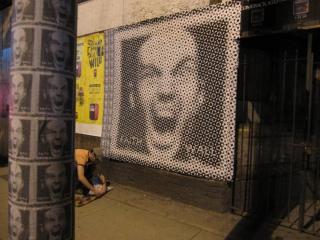
Faith Wall Camden Town?
Holy stickers Batman. These things have hit Toronto, New York, Halifax… everywhere.
Now they’ve reportedly crossed the pond. They’re going up in the UK now.
Move over Banksy. Or whatever. I have no idea what this means.
]]>CHAOS AND PLANNING: A tour of Vancouver’s public art
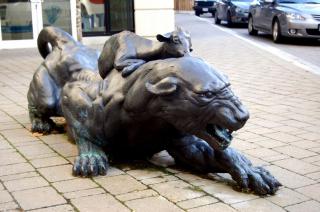
Peacable Kingdom detail
ONE: THE RED GATE
By the time you read this article, an interesting but little-known Vancouver public-art institution will either have dodged a bullet or bit the dust. I’m talking about the Red Gate. And because of the timing here, I don’t know if I’m talking about it in celebratory or funereal tones.
Sometimes referred to as the “Rainbow Art Institute,” the Red Gate is (was?) a non-profit art and music space run by Jim Carrico in the 100 block of West Hastings Street in a rapidly developing part of Vancouver’s Downtown Eastside (DTES). In the spring of 2011, Carrico—who describes the ramshackle space as a “cultural wildlife refuge”—received eviction papers from the city. And with that, a drama of survival that had played out over the Red Gate’s entire history reached its pivot point.
Why was the City acting, all at once? The 30-day notice to vacate cited building-code violations and fire-risk issues, deficiencies that might not surprise a casual visitor to the building. It’s old and obviously in need of some repair. Still, many people were outraged at the eviction notice, since the building has been in that condition for many years. The decision to evict seemed unfair, and worse, it seemed counter to the city’s insistence that DTES development would follow a “mixed-use” as opposed to “gentrification” model.
So there was an outpouring of protest—full disclosure, myself included. I’d like to think that it all contributed to the city granting Carrico a 60-day extension. And while, at the time of writing, the axe still hangs, it seems clear that it will have fallen by the time this article is published if Carrico has not by then been able to secure an agreement from the building’s owner, Moshe Mastai, regarding long-term occupancy. Without that agreement, the city will not commit funds to make necessary improvements to the building via its Cultural Infrastructure Grant Program. No long-term occupancy agreement, no funding, no improvements, no more Red Gate.
Should we care? Yes, we really should. The Red Gate is anarchic and uncontrolled. It’s part of no overall city plan. It’s not a place with established programs or rich patrons or an influential board. People who use the Red Gate—musicians and artists, primarily, street artists and otherwise—hang out there. They create art. They make music. The latter wafts through the space while the former flutters on its walls and spills into the alleyways of the neighborhood. Ballpoint-pen drawings and plywood-mounted paintings, Kevin House miniatures, ominous gas-mask stencils by Vegas, posters by Take5, Carrico himself plus dozens of others, legendary and unknown.
Is the Red Gate a gallery, then? A public-art factory? It’s both, sort of, sometimes. I’ve seen the street-art work of artists who frequent the Red Gate in locations as far-flung as South Granville and Burnaby. But artist Kevin House also sells his work at more typical indoor Red Gate shows. And I was once glad to broker a deal involving a visitor to Vancouver who desperately wanted two large black panels done by Vegas and Jerm9 (both Red Gate affiliates at one time or another), which had been hanging previously on the back wall of the Cambie Hotel—itself another anarchic, hybrid gallery/public-art project called The Eye Level Review, brainchild of the artist Andrew (A01) Owen.
So the Red Gate is outside definitions. It’s outside systems, eluding the machination of master plans. And that, I submit, is why city planners have had such a hard time understanding it, even though the Red Gate manifestly contributes to the “mixed-use” model of development in the DTES that every one of them will officially espouse.
But maybe all that is less important than pointing out that the anarchic, chaotic, hybridized, un-pigeon-holeable nature of the Red Gate is also why so many people respond to it and want it preserved. The city as governed may depend on bylaws and zoning regulations, codes and conventions. But the city as lived, as experienced by its citizens, depends for vitality on spontaneity. The livability of urban topographies depends on those zones thrumming with the sheer presence in numbers of artists, filmmakers, writers, publishers, theater troupes, as well as a whole range of independent businesspeople in technology, architecture and the law. Neighborhoods like the emerging DTES in Vancouver—we can probably think of similar neighborhoods in other cities we’ve visited—come across, in their street life and restaurant choices and number of languages being spoken, as cultural moshpits. And that’s their crucial offering. Because we need the unplannable to encounter new ways of seeing the world. We need disorder for new ideas.
New ideas. We really want those. I really want them.
I wrote a novel, published in the spring of 2011. It’s called The Blue Light Project and one of its three central characters is a street artist, whose work intrigues, mystifies and ultimately illuminates the city where he lives and works. The street artist’s name is Rabbit. It’s tempting for a writer to claim that a character came from the ether, stepping from nothing into a creative whole. But this is rare, at least in my experience. When I first thought about this character, having been critically inspired by the vibrancy of street art in the DTES in that pre-Olympic clean-up era, I went immediately to Jim Carrico at the Red Gate. Carrico introduced me to the legendary Vancouver graff writer and street-art historian Take5, who was my first window into the scene. From there, through many following introductions and excursions out into the unplanned night of the street artists, the tissue of my character began to form and shape itself. Rabbit came to life. So I wrote about him and finished the book. And when I follow the creative chain backwards now, I see it linking from the published book back through all of the people I met, back through Take5 and Carrico and all the way back to the neighborhood and the city itself.
Rabbit was given breath by the Red Gate, in other words. And while I’m sure the world can live ably with one more or less fictional character, I’m equally sure that we should protect the institutions we know can, through their creative energies, create life in the community around them. Will the Red Gate be able to do this in a year’s time?
One Cultural Infrastructure Grant, given or withheld, appears set to determine that.
TWO: THE EVOLVING TAXONOMY OF VANCOUVER PUBLIC ART
“Cultural Infrastructure” is a key and laden phrase, of course. We need some aspect of our culture to be chaotic and unpredictable, but the fact of the matter is that a great deal of it is also planned. And the name of the grant on which the Red Gate depends suggests a civic responsibility to build out the physical grid of Vancouver with another, more ethereal, layer. Floating above the sewers and water plumbing, above the paved streets and concrete sidewalks, above the traffic and street lights and the electrical and telecomm wiring, above zoning regulations and byzantine bylaws, something gossamer and ineffable: culture. And specifically, for the purposes of this discussion, that arguably more mysterious thing: public art.
The city is responsible for planning a lot of public art already, make no mistake. The online Public Art Registry records around 400 pieces scattered through the city and dating from as far back as 1905, when the Queen Victoria Memorial Drinking Fountain by James Blomfield was installed in Stanley Park. The last listed year, 2010, shows 12 commissioned works, the most recent of which is Ken Lum’s popular Monument for East Vancouver.
Since the early ’90s, art in the registry has come to life in one of two typical ways. It’s directly commissioned by the city or the park board under specific programs, like the Canada Line Public Art Program, the Olympic and Paralympic Public Art Program in 2010, and this year’s public-art program tied to the City’s 125th anniversary. Alternatively, the work is stipulated in private development permits, an art budget being mandated in each case according to a formula based on buildable gross floor area. Developers can choose to remit the budgeted amount to the city, letting them allot it to art projects as they wish. Alternatively, developers can choose to keep some or all of the art budget on-site, in which case they must adhere to a public selection process involving a selection committee facilitated by a public-art consultant.
Against what measure are artworks chosen in either instance? Well, here we get into a murky mix of selection-committee dynamics and civic direction. In the case of Southeast False Creek, a newer area of development in Vancouver that has a number of significant public-art installations, that civic direction was codified in a document called the Southeast False Creek (SEFC) Art Master Plan. Look it up online. It’s informative in terms of visualizing how a city engages with the production of its “cultural infrastructure.” The document was prepared by Buster Simpson, a Seattle-based artist who has written nine master plans for different municipalities and created dozens of public-art installations in North America, including Vancouver’s Brush with Illumination, that spindly, tripod-mounted probe floating enigmatically in False Creek just east of David Lam Park.
To say the SEFC Art Master Plan reflects a bureaucratic process is an understatement. The 50-page document credits no less than 45 contributors: 19 from the city, six from the park board, six from VANOC, four First Nations representatives and 10 miscellaneous, including architects, art consultants and reps from Pinnacle, Polygon and Telus World of Science. The net result, as you might expect, has a stakeholdered feel to it, if I can coin that term. It has been deliberated and consentualized to such an advanced degree that it’s easy to forget—while you’re reviewing the “guiding principles,” the “themes,” and other dictates—that the document is addressing itself to specific works of art, as opposed to the more general design question of what the buildings and greenways and street lights should look like. I make this point not to set art against design, but to illustrate the double bind in which any city finds itself regarding public art. The municipality either takes responsibility for the process, exposing it the demands of the electorate and realities of governance, such as accountability and representativeness, or it hands the whole business to some unelected outsider, who presumably would have to be an artist or curator considered so knowledgeable about art that they could be trusted. Call that the Art Czar approach and ask yourself if Vancouver would ever have the stones to try it. Handing the city over to Damien Hirst for a few years might be an exciting experiment—we’d get a lot of press—but setting aside the price tag, there seems little doubt the results would leave at least some Vancouverites unhappy. (I’m visualizing a killer whale in formaldehyde, but I’m sure Hirst would think of something better than that.)
So we do it the more democratic and necessarily more bureaucratic way here in Vancouver, for some defensible reasons. And the net result is we now have over 400 art works up in Vancouver, a surprising amount of which is entirely invisible. That last detail may be surprising, but I’ll wager that wherever you live in the city, there’s a piece of commissioned art work you pass every day without realizing it. I confess that I ate my lunch sitting on Daniel Laskarin’s Working Landscape for several years before I figured out what it was. (You’ll find it in the greenway connecting Hastings to Cordova streets, in the 900 block. Four big turntables with planters and benches on them that would, no doubt, be more noticeable if they were actually turning, as Laskarin had intended.) But this reality, in any case, is one that public art shares with its chaotic cousin, street art. You tend to notice the new pieces, your eye registering a change in a familiar landscape. But you have to train yourself to see the art that changed the landscape before you started looking. When you do, the art blossoms into something like an independent ecology with its own taxonomy of species, each with their own arcane tracks and signatures and distinctive scat. [Hilarious!]
There would be any number of ways you could organize that taxonomy in Vancouver. The inventory has stylistic and geographic clusters, as you might expect. But what I noticed most on my public-art hunts preparing this article—poring over the online registry, then expeditioning the city to find various pieces—was the seemingly evolving civic need to which public art of different eras seemed to respond.
Prior to 1950, the registry records 39 public-art works, and these works are dominantly found in the old power centers of the city: Mount Pleasant, Shaughnessy, UBC and, of course, Stanley Park. There was no formal public-art program during these years. So while some installations were paid for publicly, such as $4,500 paid to Charles Marega for his 1911 bust of David Oppenheimer, which is found at the Beach Avenue entrance to Stanley Park, others were gifts from donors, like the Joe Fortes drinking fountain in Alexander park near English Bay, installed in 1927, five years after Fortes’ death. To what end did this work seem to be directed? Well, this requires generalizing, which is sketchy business. But it is fair to point out that a lot of the work from the period was memorial or commemorative in nature, reminding us of our most esteemed citizens and senior leaders. So it is that Vancouver has cenotaphs (at least two that I’m aware of: one in Victory Square and the other in Grandview Park), plus tributes to notables including George VI, Captain George Vancouver, Robert Burns and Pauline Johnson.
As the ’50s turned into the ’60s, you see a new sort of public art emerge. There are still memorials going up, like the Lord Stanley statue that finally went up in 1960, 52 years after his death, or the 1970 statue of Gassy Jack at Carrall and Water streets. But other works seem to respond to a more purely artistic impulse. The Robert Clothier sculpture Three Forms and Gerhard Class’ Configuration, both at UBC, are abstracted forms not obviously connected to a specific memorial function. Art for art’s sake, you could say. Class, in fact, might have contributed more than any other artist to this change. He was the creator of a number of significant memorial pieces here: the Hastings Mill Memorial on Dunlevy Street, the Province Newspaper Memorial in Victory Square, a memorial sundial at Beach and Denman streets dedicated to the first Englishmen to stake land claims there, as well as the Queen Elizabeth Plaza Centennial Fountain outside the QE Theatre. Yet Class was also a key organizer of the International Sculpture Symposium at Van Dusen Gardens in 1975, which brought us 12 pieces by internationally renowned modern sculptors, all work that has a more artist-driven than civic-driven sensibility. But the same could be said of later work, like the 1979 bronze Bird of Spring by Abraham Etungat on the stairs leading down to the plaza next to the VAG, or Letha Keate’s statue of two children frolicking naked on a log outside Brock House in Point Grey, realistic to my eye but for the oddly enlarged, vaguely alien-looking heads.
Heading into the ’80s, the art-led monumental remains. In 1980, Alan Chung Hung’s Gateway to the Northwest Passage was erected, that massive steel square on the Vanier Park grass, framing the West End and Garibaldi Highlands, or the planetarium, depending on whether you look through it north or south. His red Spring in Robson Square (1981) is similarly assertive, a brilliant work to my eye for its capacity to look huge and weightless, to appear like it’s holding up and holding down the building at the same time. And at the other end of the decade, in 1987, Alan Storey unveiled his Pendulum in the HSBC building lobby, which makes its own silent statement, at once serene and intimidating.
But in other work from the period, a newer program can be detected, the first murmurs of message. I sense it in sculptures like Vessel by Dominique Valade (in Discovery Square downtown) or the stone Anchor out on Spanish Banks by Christel Fuoss-Moore, both of which were installed in 1986 and use geometric abstraction in evoking symbols of the city’s nautical history. Gastown’s Fish Fountain by Sam Carter and the Ring Gear mounted at the east end of Pacific Boulevard near the Cambie Bridge seem similarly tasked. These works echo traditional memorial sculpture of the first half of the century. (Which didn’t stop being made in the ’80s, either. The decade brought us three new statues dedicated to historical figures: runner Harry Jerome, Judge Angelo Branca and Vancouver’s first archivist, Major James Matthews.) But the newer work is different in that it’s not dedicated to heroes or noble leaders. It’s dedicated to our own fast-disappearing past. The work seems designed to remind us of who we once were, right at the moment of our Expo-era transformation.
Then, of course, that all happened. The real-estate revolution, money flowing through global veins, and everything started to change. Official public-art programs began during this period, no doubt in part as a response to the joint opportunity/threat that eager developers represented. The net result was 107 new works in the next 10 years, a mix of civic- and private-development projects. The memorial and the monumental were still to be found. A Rick Hansen statue. A Shauna Gillies Smith redesign of traffic circles, marked with enormous boulders. (There are three of these along Garden Drive in East Van and they are delightfully strange.) But far more prevalent during the period was work addressed to what had become the newest and most consuming topic of conversation in Vancouver: ourselves.
History continued to feature in this new discussion. Bernie Miller and Alan Tregebov used images of old False Creek in their controversial Street Light (which residents tried and failed to have removed) and Henry Tsang used the historic Chinook language in his magical Welcome to the Land of Light, both on the False Creek North seawall. Elsewhere, Make West by Bill Pechet and Ten Thousand Faucets and Doorknobs by Joey Morgan make use of actual physical artifacts (old saw blades, broken faucet handles, etc.) to ornament new condo towers (in Coal Harbor and on Seymour Street, respectively), under whose footprints the referenced history is entombed.
If there is a mounting irony in this work—paying homage to a past so culturally different than the present, and to which many would wish to see no return—perhaps it explains the response of a newer category of work that came to dominate this period. These are pieces honoring the quotidian details of who we are and what we do now. Bike seats high on masts (Big Bike by Bob Potegal and Barry Luger, QE Park), grand neo-classical dining tables just like those in the living rooms of the surrounding towers (GRANtable by Bill Pechet and Stephanie Robb in SEGS Park), bicycle wheels and rakes hoisted proudly (Bicycle Wheelby David MacWilliam in Riley Park, Utility Pole by Mark Simcic at Oak and 37th in rake-friendly Shaughnessy). There’s something insistent about this work, a trace of concern. As the future poured into Vancouver and the city transformed, up went the monuments reassuring us that we retained a stable sense of who we were.
Extending this logic only slightly farther, we arrive at a vast category of work—beginning in the ’90s but extending up to the present—designed and/or actually made by the communities in which they appear. Here the artist becomes what might be thought of as an identity facilitator, and by the time of writing we have commissioned and built literally too many of these to list: from Mount Pleasant’s Community Fence carved by residents in 1994 to Jaimie Robson’s Our Community Story in 2005, tile installations based on the stories of Hastings Sunrise residents. Forced to choose a pinnacle example of the form, I’d go with the Dunbar Community Center’s Glass Tile Wall from 1996, conceived by Miyuki Shinkai, composed of 300 community self-portraits painted on glass. Here we have the community not as mere beneficiary of public art, but as its source and subject as well.
Which brings us to the present. Over 100 more works were unveiled in the 2000s, a lot of it (although certainly not all) falling into these now-familiar categories: pieces referencing history or describing ourselves, pieces designed or executed by community members. And this accumulation of numbers hasn’t necessarily served the individual pieces, it has to be said. Repetition breeds familiarity, which tends to kill the possibility of a spontaneous, unpredictable viewer response.
Consider all those pieces referencing site history. By the 50thtime you’ve seen this technique deployed, its meaning starts to thin. That’s my primary response to a work like Lookout on the False Creek north seawall, two pavilions made of glass and stainless steel that have been etched and carved with words chosen to evoke historic False Creek: wheel, pit, coal, shed, tar, dipper, etc. It may have been the artists’ intent to show the emptiness of the gesture. The more pressing problem is that it feels so much like Concord Pacific Group branding. We’ve seen branding before. We know what it signals, someone trying to sell us something. And with the fingerprints of intention and planning all over it, the mystery is gone. For public art to work, I wonder if its motives can ever be quite so transparent. Perhaps some aspect of it must remain hidden to intrigue, to excite, to involve.
The “artist’s statement” may be the artist’s worst enemy, in this regard, because of the risk that the artists themselves end up explaining the degree to which they’ve succeeded in meshing sensibilities with something like a master plan. I was fond of those big sparrows, The Birds, by Myfanwy MacLeod in Southeast False Creek until I read about them. Here I had been enjoying the way they stood astride the plaza, seeming to exist in spite of, not because of, the development. I liked their defiance, their aura of threat. (Plus, for some totally illogical reason, they brought to mind the Welsh proto-metal band Budgie.) All that thinned out for me when I read that the sculpture was intended to reinforce the “problem of introducing a foreign species and the subsequent havoc wreaked upon our ecosystems.”
So it’s about sustainability, I thought, reading. Oh no. We all should have stopped at the big birds. We should have left them gazing silently into the distance high over the heads of passersby, a whiff of potential hostility about them, potential chaos. Those birds had a little Red Gate in them, I thought, until they were given a political mission, and with a click they then toed the master-plan thematic line and all mystery and threat went out of them.
And here’s where we arrive at what may be the central dilemma of planning art. Two decades into the officially planned part of our public-art accumulation, maybe we’ve actually gotten too good at it in Vancouver. We make slick master plans. We select art skillfully to match. Then we communicate these planned messages to the public, tearing back the cover, revealing the hidden, and draining all tension from these projects.
Which doesn’t have to be the case. We have numerous public-art works in Vancouver to prove it. I’ll name two, although there are of course more. Why do people seem to love Ken Lum’s East Van sign, shining westward from the top of the hill at the corner of Clark and Great Northern Way? Researching this essay, it came up positively in numerous conversations. The sign is a nod to collective memory itself, of course, invoking a near-sacred image of East Van’s history that people remember seeing since at least the ’70s, scrawled in felt pen on the back of bus seats and carved into bathroom doors and, yes, tattooed onto the arms of certain bikers. Why does this hearkening-back not feel like the same-old, same-old neighborhood branding?
Because the recollection is not uniformly positive. There’s tension remaining in it. The sign doesn’t point into East Van after all, it faces downtown. It’s defiant. And when I ask Lum directly about it, his own response reflects this reading. The idea all along, he says, was for the sign to oppose a feeling, popular at the time of its commission, that East Side/West Side cultural divisions had been somehow leveled by real-estate development. That was never true, Lum says. If you were a Filipino nanny, you lived on the East Side. If you didn’t speak English, you lived on the East Side. Divisions remain. So while the sign evokes history, it does so in what Lum describes as a “tortured, tormented” way. And while I’ve never been a fan of the now massively popular biker aesthetic, to which the sign gives a nod, I acknowledge the sign’s freedom from thematic control and appreciate that it’s not trying to convince me of anything particularly, rising blue and cold in the night air, shimmering and elusive instead.
That sense of uncertainty—the work provoking emotionally and intellectually, but in an unpredictable and open-ended way—is very closely related to the reaction I had to Tom Dean’s Peaceable Kingdom. In the courtyard of the King Edward Village condo/retail development at the corner of Kingsway and Knight streets (surely the loudest intersection in the city), you will find a remarkable series of 22 life-scaled cast-bronze sculptures. A panther lies taut and snarling, ready to pounce as a kid goat licks its ear. A sow lies happily entwined with a python, while her piglets snooze nearby. A bear cub sits with a child, while three otters watch from near a waterfall. A crazed-looking beaver and his posse of rat friends peers at this tableau from around a corner, while above hangs a family of sloths, and high on one of the building’s upper ledges looms a vulture.
The impact of the work is intense and immediate. Casting in bronze is a complex nearly obsolete process, as project art consultant Lynne Werker points out in her Architecture BCarticle about the installation from April 2009. But it lends a gravity and permanence to the drama here that is deeply compelling. It contributes to the feeling that this work rises, as Werker says to me in a later interview, “to a more universal inquiry, a higher level set of oppositions.”
Those oppositions, and the uncertainty to which they contribute, charge the work with energy and give it focus. Standing in the courtyard—or more likely wandering back and forth, as the dynamic between the various animals, given physical geometry by the crisscrossing of their sightlines, draws you into motion—you’re aware of this work concealing as well as revealing. There is an unanswered question captured here. And even knowing that Dean had suggested in his proposal that he wanted to depict “serene beasts coexisting in a precarious sensual paradise,” and that he’d drawn on literary texts like Isaiah’s prophecy of a messianic age or Portia’s pronouncements on divine grace from The Merchant of Venice (as Werker explains to me), does nothing to remove or prematurely resolve the central tensions at play in the individual groupings, and between them. The panther is knotted with a repressed instinct to kill, but does not kill. Or not yet. The sow squirms, suffused in pleasure that the python could extinguish with one slow flex of his many coils. The bear listens to the benediction of the naked child, around whose shoulder his clawed left paw is casually thrown, lost in a train of thought that cannot quite be declared either hostile or benign. The otters are wary. The piglets unaware. The sloths infinitely patient. The beaver and the rats are scheming, but to what end? What is their plan here? What will be the outcome, as the vulture rustles his wings on the ledge of the building overhead, either settling into place or set to take wing, to darken the courtyard in his shadow, to signal his expectation of some imminent, bloody turning? There is peace in this Peaceable Kingdom, but only in the instant of our viewing. The future here is fragile. And the viewer (this viewer certainly) stands riveted, involved, implicated in some core and crucial human truth.
Tom Dean produced this work, it should be noted, for the Aquilini Investment Group. That is, he was working within that bureaucratic process mandated by the city. It involved a selection committee, facilitated by Werker, which included a representative from the developer. Aquilini could have gone into this process demanding that some detail of the neighborhood be teased out into an aesthetic motif useful in packaging the condo development for sale. But they selected Dean instead. And after receiving the commission, Werker describes Dean rigorously following his own vision. “He put his heart, mind and soul into this one,” she said, noting that three of the six animal groupings were not even in the original budget. He determined that these were needed and included them anyway, adding his own financial investment to the other things he had already committed to the project. Did he consider, I asked Werker, whether the future tenants of the building might think about the work?
She responds succinctly: “It’s not really in Tom’s process to wonder about that.”
Artist-driven. Brimming with idea and the suggestion of a concealed truth. No trace of mandate or message about it. Dean’s work succeeds magnificently by eluding the control of any process, any client, any bureaucratic method, by asserting itself and encouraging us likewise to react to it in our individual and spontaneous ways, born in the moment and impossible to anticipate.
Tom Dean’s work at King Edward Village is alive. And the viewer feels alive around it.
THREE: BRING BACK THE SPRING
After I learned about the Red Gate and talked to Jim Carrico, after I’d been introduced to Take5 and a number of other people, there followed a period of time when I enjoyed falling down the rabbit hole that is street art. And the deeper I went, the more I saw that inspired me. The more Rabbit came to life. What was it about this work that was so animating? I watched my new artist friends work and tried to figure it out.
I watched Byron Cameraman and Rich S put up one of their Orwell-inspired posters at Hastings and Main, at one in the morning on a cold Saturday in January. I watched the crowd gather and the ripple of excitement pass through them as the final words of the poster went up: Freedom is Slavery. I heard the cheer. People were cheering. A man yelled—in real life, as he does again in the pages of my book—“That is black and white, man! That is black and white!”
I watched A01 cover the DTES with his photocubic surfaces, pictures at 1:1 scale of urban textures, postered up directly over the objects they depicted. For a while they were invisible, hiding in perfect camouflage, as it were. Then they exploded to life, as A01 shifted his attentions from surfaces to flowers to people, the neighborhood excitedly beginning to realize that it had been the inspiration for and the very substance of this ongoing, obsessive street art project.
I watched JermIX put up his banners, annotations of the here and now. Comments on the everyday. On a bus shelter advert: Consumerisn’t. On a brick wall: You can’t always get what you want. Once, on a dumpster at the mouth of an alley leading east towards Main just off Cordova, a riddle, a warning: Don’t walk this Way. I saw that and found myself somehow precariously involved.
Then in late winter 2011, snow still on the ground, I went out again with Byron Cameraman. The book was just about to be published, so I was past research, just watching him do his work. Plus, Cameraman said, his friend Pete’s truck was in the shop and they needed help transporting the installation to its site.
I picked them up at the agreed place and helped them load 10 or 12 placards on long stakes, photos pasted to each side: colorful shots of foliage, leaves, lively flowers and green tree branches. Bring Back the Spring, it was called in total. So I drove them to the designated place, surprisingly enough in Shaughnessy, where I might not have expected Cameraman to make his contributions to the spontaneous civic art experience. But there we were, on The Crescent [is this the street’s formal name? It is, yes.], unloading the installation and carrying it to the very centre of the park, to a particularly high bush of rhododendrons, flanked by sapling maple trees, both stripped by the season and the cold, the lowering mist that made us glance around ourselves and shield our cameras, wondering if we were about to get soaked.
Cameraman went to work, positioning his photographs of spring in its details: the turn of a leaf, the curve of a blossom. Each placard positioned exactly in front of the detail that its photo depicted, remembered spring over living winter. And if you walked behind the installation, since the placards were two-sided with 180-degree opposing views, like magic you found yourself looking at the same tableau from the reverse angle: each sign a two-way window back to the spring behind us, suspended ethereal in the close and surrounding presence of winter’s now.
It was impossible not to imagine people wandering by the installation later and wondering about it. We talked a bit about that, although Cameraman, like Tom Dean, does not have it in his process to over-think these issues of public reaction. Responding to some impulse, his work gets made. But I could linger in the consideration because I was, at only one step closer to the source, one of those same reacting members of the public. Why was this work as animated to me as it was? The tableau was ambiguous, in the end. A glimpse of the past that suggested the future, but was it hope or was it a foreshadowing of winters to come, across time without measure, the endless return of night?
Cameraman didn’t volunteer readings, either way. His motives are obscure on every level, including why the work goes up in the first place—unpaid and, for the large part, unacknowledged. But that may be the strongest clue right there as to why his works affects people as I believe it does, involving them with a pull on the mind and the heart, with the suggestion of a riddle at the heart of human affairs. The ambiguity is the energy, freeing the work, releasing it from our control, opening our responses to the unpredictable, the spontaneous. People would come along, I knew—walking dogs, pushing strollers, jogging, holding hands, out in motorized wheelchairs—and they would wonder. And there was always the possibility of new life in wondering.
In the end, whether the Red Gate survives the next couple months or not, that is the question I think we have to ask ourselves about the art that grows around us, through official public-art programs and through the instructive chaos of street life: is the work alive? Because if it isn’t, how can it bring life to the city around it?
]]>Edited by Richard Rhodes
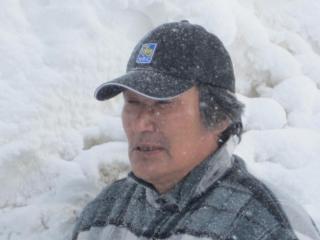
Zacharias Kunuk: photo Timothy Taylor
Final descent into Igloolik and I’m feeling the cold already. It’s seeping into the plane, into the soles of my feet, stiffening my knuckles and knees. It seems to be reaching out toward me, and I find myself thinking about the story a man told me an hour ago in Iqaluit, just prior to departure. Joseph Palluq was sitting beside me on the shuttle from the terminal to the plane. He turned to me, spotting a first-time visitor to the Arctic, and decided I needed to hear his story about hypothermia.
Perfect timing. I’d just been telling him I was up there with the photographer Donald Weber to visit the Inuit filmmaker Zacharias Kunuk. “You guys know Zach?” Palluq asked. I said no, but that we were interviewing him about his new film, Qapirangajuq: Inuit Knowledge and Climate Change.
“Huh,” Palluq said, impressed. It meant something that two “southerners” would travel all that way to talk to a man he’s known since grade school, a man who may now be Nunavut’s most famous citizen. Then, apropos of climate change, along came the story about hypothermia.
Palluq had been a teenager when it happened. The weather had been mild that day, so he’d dressed only in a light jacket when he went out with the dog team. A few hours later, far off on the land, the weather radically worsened. The wind picked up. The snow started. The dogs lay down in the mounting drifts and refused to move. He was stranded. And by the time 12 hours had gone by, he knew what was happening to him. He knew the symptoms: first you shiver, then you start stumbling. Pretty soon you can’t walk.
Palluq scratched late-day silver stubble, reaching this point in the story. He lives in Ottawa now, he‘d told me. He was going back to Igloolik for his father’s funeral. I wondered if this sad journey had reminded him that the man he was about to bury once saved his life.
“Then, they found me,” Palluq said.
“Where?” I asked. “How far from Igloolik had you wandered?”
Palluq tried to explain. He said, “You know the ridge above town? You know the rock outcropping past that? You know…” He stopped, looking at me again. “But you’ve never been to Igloolik before.”
“No. I haven’t.”
He shrugged. He smiled. “Ah, well.” Then he drifted away.
I’m thinking about this last comment as the landing gear drops, as the ground nears in a blur of white and blue, as we thump down to the tarmac, as the Igloolik Airport hurtles by in a rainbow spray of ice crystals. I’m minutes from finding out my luggage is still in Iqaluit—a separate matter. Looking out of the window, I’m thinking about what Joseph Palluq told me, and I think I know what he meant. He wasn’t being dismissive. He was only saying: if you’ve never been to Igloolik, if you don’t know the ridges and the outcroppings, the line of the shore and the way the tongue drifts form in the winter season, how could I possibly explain where exactly I was when my father found me, half-dead and about to slip permanently into the very heart of this cold?
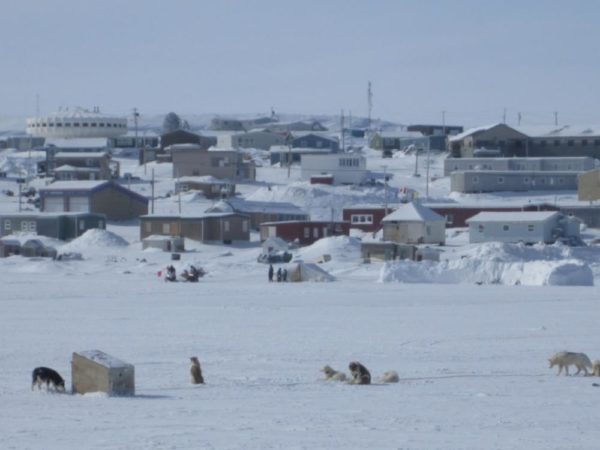
The Inuit landscape is Inuit knowledge, I’ve read. And this idea is critical to Kunuk’s work. In Qapirangajuq, he did something nobody had done before, though it now seems obvious. He let Inuit elders talk about the landscape—the land, the sky, the wind, the water, the ice and the animals—that they have spent a lifetime watching. He let them map their own experiences of climate change. No biologists or meteorologists. No scientific explanations. Just those voices and the steady Kunuk lens, which viewers will recognize from his films Atanarjuat: The Fast Runner (2001) and The Journals of Knud Rasmussen (2006)—a calm frame in which traditional knowledge survives amid modern pressures.
The elders speak, in Inuktitut words like the sound of water tumbling over round stones, and their voices weave into a braid of common wisdom, which stems from watching the environment. All Inuit are taught from the time they’re kids to check the weather each morning. The Inuk environment didn’t figuratively shape the community, then. It literally framed the possible. And so, as that environment has started to change—the atmosphere heating more rapidly here than in any other place on earth—tremors are felt at the very core of Inuit culture.
Kunuk meets us at the airport. Born in 1957 to a family still living on the land in qammaq sod houses, he was nine years old when he moved to Igloolik for school. He has lived on both sides of the traditional-modern divide. But after picking up his first camera in 1981 (a Sanyo colour with a Portapak), Kunuk began a video-art project that would keep one foot in each camp forever. Today, at 53, Kunuk is an internationally known figure, having received senior film accolades, including a Caméra d’or at Cannes. All the while, he has carried on life in Igloolik, hunting and socializing and raising his family, largely disregarding this global acclaim.
A sturdy man of medium build, he meets us dressed only in a black-and-grey lumberjack shirt, jeans and heavy boots. His Jeep is candy-apple red and, in this hamlet of nearly 2,000 people, Kunuk waves or nods to everyone we pass, from elders to kids trudging along the hardpack roads in hoodies and toques—no mitts—faces mottled across the cheekbones by repeated deep-tissue encounters with frost.
“Let me show you the community,” he says. So Kunuk, Weber and I drive from one end of it to the other, a couple hundred timber-frame buildings strung along a crescent beach opening southeast onto Foxe Basin. Kunuk shows us the medical clinic, the youth centre and the research station that looks like a UFO mounted on top of a pole. We drive all the way through town and on toward the dump, where the enormous ravens gather and stray dogs go to die. Our plan is to visit the hilltop cemetery where the grave markers date back 300 years, but we can’t make it up the grade—Kunuk’s four-wheel drive was taken out by a rock last summer. We slip and skid, then turn around and head back toward the hamlet.
He tells stories—he’s not reticent, as I’d been half-expecting based on other interviews I’d read. Far away from home, Kunuk is capable of going monosyllabic, but at the wheel of his Jeep, tooling around his own town, a speck in the midst of Nunavut’s vastness, he is in the place that defines him and his work just as surely as wind direction and cloud formation have always defined the Inuk day. He has tales to tell in this place. And one sticks with me powerfully, for how it brings to mind the vast distance we’ve crossed to get here, a distance measured not only in kilometres but also in centuries.
It’s a story about his grandchildren. Two of them, a boy and a girl, have been hurt in separate accidents in the past couple of weeks. Not seriously, but there was a broken leg in the case of the grandson. Kunuk darkens as he tells us this story. The coincidence doesn’t sit well with him. It is as if he senses that the ancient forces are still alive in the contemporary world. When I ask him what he is thinking, he doesn’t answer right away. Finally, he says, “In the old days, it would have been a message. Today, I don’t think it’s worth it to think so.”
Then he laughs what I’ll come to appreciate as a signature laugh, a high staccato chuckle with a Player’s tobacco note that fades down to a murmur, a sigh, a last letting-go.
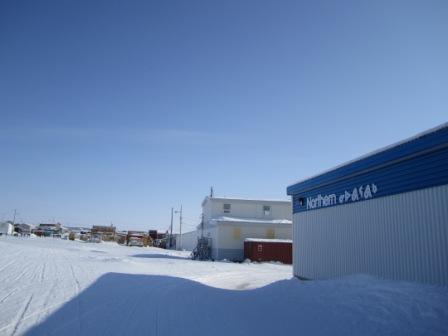
I struggle to sleep, as a southerner will. At midnight, the sky is opaque blue. Kids are still howling around town on their skidoos. When these sounds fade, there is silence for a while. Then a bumpety-bump, a clackety-clack moving on past my window and down toward the Northern Store. I get up, pull back the blinds and see a small boy running down the frozen road, hockey stick bouncing behind him. When I wake again later, in the small hours, I find a blush of rose still lingering at the vanishing edge of the visible.
In the morning, Kunuk meets me over at the IsumaTV office on the main road, which looks out over the bay. The operation has produced feature films, documentaries and a television series called Nunavut (Our Land) (1994–95), and its nerve centre is the upstairs editing suite, lined with maps of the Arctic and display cases full of the accumulated artefacts of Kunuk’s life and career. IsumaTV, which owns the rights to all Kunuk’s work, is in fact a new entity, since Kunuk’s film production house, Igloolik Isuma Productions, filed for receivership in Quebec in early July. But you would never guess that from the office itself, which still teems with the evidence of work done and work in progress: charts and maps relating to Kunuk’s newest film, about the Cree-Inuit wars, plus award statuettes, film posters, oil lamps, a polar-bear skull and a walrus penis bone, as well as the pair of rubber feet that the actor Natar Ungalaaq wore during the scene involving Atanarjuat’s famous naked run across the ice floes.
This office was also where Kunuk made Qapirangajuq with co-director Ian Mauro (an environmental science PhD, now Canada Research Chair at Mount Allison University) and the Igloolik elder Augustine Taqquraq, who was brought in to advise on the Inuktitut language and cultural matters, and who participated in the editing of the film. An anecdotal approach drives the documentary. “We all know how scientists talk,” Kunuk says. “We’ve been listening to them for years. But nobody listens to a 92-year-old man saying: ‘You think this is cold? It used to be a lot colder.’”
Kunuk and Mauro let the elders speak, and a remarkably consistent story emerged. The elders told of rising temperatures and thinning ice, disappearing icebergs and permafrost melting to the point that lakes were vanishing into the softened earth. These elders also spoke about the sun and stars, in a series of accounts that Mauro now describes as “mind-blowing.” Across the Arctic, the same story: the stars were out of position and the sun was setting in the wrong place on the horizon. One elder observed that the sunset had moved from one side of a landmark mountaintop all the way over to the other, which led him and many elders to conclude that the axis of the earth has tilted.
Mauro investigated, contacting NASA and other experts, and determined that atmospheric refraction was the culprit. The air is heating rapidly in the North; when contrasted with cold surface temperatures, this causes a mirage that allows light to bend around the curvature of the earth. Inuit are now seeing the sun return above the horizon much earlier in the season, and in a different position than expected. These observations leave the impression that the earth has tilted. Proof of this refraction explains the visual anomalies that Kunuk hauntingly captures in the film: the sun shimmering and elongating unusually at the moment of its return after the long polar night.
This part of the story got plenty of press, understandably. Southerners—even those in big cities who never see the stars or notice the shape of the sun—quickly grasped the metaphoric and scientific significance of Inuit elders’ descriptions of the tilted axis of the earth. These elders had generated new insights into climate change ahead of the scientific community, and this shocked and inspired many. But the quieter aspect of Kunuk’s film, which unifies it artistically with his other work, is the way in which Qapirangajuq positions Inuit knowledge and its critical relationship to landscape as a fragile cultural artefact suspended in the spreading web of global modernity.
Tensions surrounding the Inuit hunt illustrate this point: long-sustainable Inuit traditions now face opposition from both scientists and environmentalists. The Inuit lost their seal-hide economy years ago due to urban liberal squeamishness. They’ve had to do battle over their right to harvest the bowhead whale, a conflict between Inuit knowledge and the scientific community that, Mauro reminds me, eventually resulted in the federal Department of Fisheries and Oceans changing its population estimates “from 700 animals to more than 14,000 animals.” The looming issue at the moment is the polar bear: according to Inuit elders, polar bear populations are thriving, but many southerners believe the animals are on the brink of extinction.
This isn’t only an argument about numbers. As in all of his work, Kunuk situates this dispute in the cultural realm, in the dynamic at play between the South and North—a region he describes as having moved “from the Stone Age to the digital age in a single generation.” The Inuit have never hunted beyond what was required for survival; shamanism and its attendant taboos would have forbidden it. But in the Inuit cultural context, which was pre-individualistic and communal up until recent years, it also wouldn’t have made any sense to over-harvest for hoarding or trophy purposes.
From that long pattern of experience, meanwhile, a specific element of Inuit knowledge emerges: a conviction that populations can only be sustained through hunting. Since Inuit mythology espouses a highly enmeshed relationship between humans and animals, Inuit people will express this conviction in terms of the animal giving itself to the hunter so that its spirit might be recycled and other animals might be born. When we gather later that evening with a number of elders at Kunuk’s house, I hear the elder Abraham Ulayuruluk sing a traditional Inuit ajaja song expressing exactly this idea. “The great white one,” he sings of the polar bear, “surrenders himself to the end of my harpoon.” Kunuk, straddling that traditional-modern divide, is able to offer a smiling aside at this point, leaning over to me and saying: “Of course, the great white one doesn’t surrender unless the hunter does everything else exactly right.”
But in his office that day, Kunuk’s frustration shows when I bring up animal rights activism. “We’re a hunting culture,” he says. “We don’t farm animals. We kill animals. And our children watch animals being killed and being butchered. They watch that and they learn how to do it. And they want to learn.” 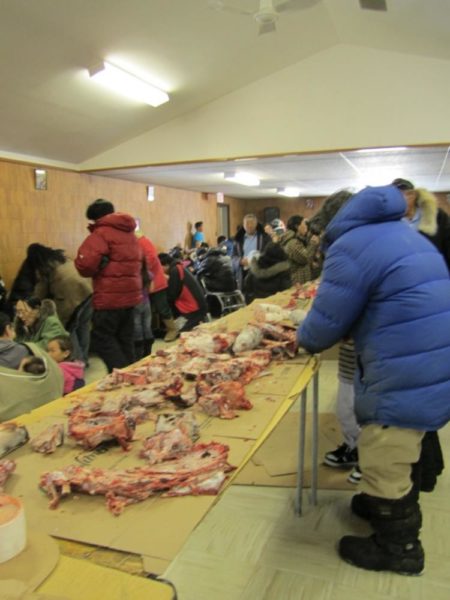
Kunuk’s pride in traditional and communal ways of life is evident in the comment. So too is his commitment to their preservation. In this respect, there is a pedagogical aspect to the IsumaTV undertaking. Episodes of Nunuvut (Our Land), set in the 1940s just prior to forced relocation, each highlight some traditional activity. You can watch these online and learn how to build stone or sod houses, hunt different animals and handle a dog team. Kunuk becomes even more enthusiastic when describing the sessions in which he gathered actors together to learn these traditions so that the films could depict them accurately. I get the impression that there’s hardly anything he’d rather do than sit with elders and learn old songs or the proper Inuktitut word for some object or concept that might otherwise be lost to history.
Walking around Igloolik, meanwhile, I sense the reach that Kunuk’s work has had in the community. He downplays it, saying, “My hunting buddies are still my hunting buddies.” But if you’ve watched his films closely, you recognize a surprising number of faces in town. Even people I don’t recognize turn out to have had off-camera roles, like the woman I speak with at the high school who is proud that she learned to sew traditional caribou-skin parkas while working in the wardrobe department for Atanarjuat.
At the same time, Kunuk’s role as a vocal proponent of community values highlights a paradox that—like the fragile suspension of Inuit tradition in that web of global modernity—places a unifying stamp on his work. It’s a paradox created by the artist himself. It requires a certain individual zeal, after all, to take on the job of conserving your community’s history. And it takes a thoroughly modern sense of self-confidence to be a film director. Kunuk is known for giving his actors a degree of freedom in interpreting scenes. Dialogue in the television series was almost entirely ad-libbed, a very Inuktitut-style approach that yielded gold on occasion. (I especially like the elders in episode four who, during a tea break while harvesting ice blocks, begin talking about a shamanistic intervention to kill Hitler.) At the same time, when pressed, Kunuk lets slip the following assessment, which is no doubt shared by many people who do the same job: “As a director, you end up doing everything.”
That push-pull tension between the individual and the community is captured pointedly in the first film to bring Kunuk really significant attention. Atanarjuat is a central myth in the Inuit tradition. Kunuk remembers hearing the story countless times as a boy, and before Paul Apak Angilirq’s early, tragic death from cancer, the Atanarjuat screenwriter spoke about how important the legend is, as it lives “right at the base roots of Inuit culture.”
That foundational story is about shielding community from the pressures of the individual. Taboo provides protection: the Inuit must never rank personal ambition ahead of the group’s needs. In this particular story, a man named Sauri and his son Oki both lust for personal power. Sauri wishes for the leadership of the local clan. His son does also, to the point of killing his own father. At the end of the story, the hero, Atanarjuat—a man who is rival to Oki for the love of a woman, who has lost his only brother to murder, and who has himself narrowly escaped death by running naked across the ice—returns to the community, sets up an ambush and finally rids the community of evil by killing Oki.
But Atanarjuat doesn’t do that in the film. In Kunuk and Angilirq’s version of this tale, Atanarjuat returns to the community, sets up the ambush and finally rids the community of evil by not killing Oki. Instead, he smashes his club into the ice beside Oki’s head and declares: “The killing must stop.”
Explaining this crucial narrative decision, Kunuk points out that he and Angilirq sought elder approval for the change, and were surprised when the elders said, “absolutely, go ahead and make the change”—because when Inuit told stories traditionally, they were always changing things. “There’s the basic story,” Kunuk tells me. “But over the years, it changes. That’s how it becomes legend.”
Then, Kunuk adds: “When you have a revenge story, it’s never going to stop. It’ll keep on going: revenging and revenging and it’ll never stop. And Paul wanted to change that, to change that ending.”
Nobody knows whether the film would have brought Kunuk any more or less success with the original ending. But it is possible to say that the impulse to preserve tradition in this case—the telling of this important tale, the depiction of Inuit culture in a way that had never been done before, the galvanizing of a community in support—depended on an artist for whom Oki’s death would represent “revenge,” not justice. That is, it’s a modern artistic imagination that made this film, charged with the willingness to change, to evolve, to eschew conventional wisdom on occasion and to adapt with the times. And that seeming paradox on the part of the artist himself is what marks each of Kunuk’s films most indelibly: a sense of tradition being protected and nurtured in the hijacked train of history as it hurtles into the future.
The closing scenes from The Journals of Knud Rasmussen offer the most poignant illustration of this last point. In real life, Rasmussen’s men travelled from Greenland and came in contact with Avva, a shaman holding out against the widespread conversion of Inuit people to Christianity in the 1920s. Rasmussen’s journals, as enacted in the film, show Avva’s answers to various questions, including this one, to an inquiry about his shamanistic religion: “We believe happy people shouldn’t worry about hidden things. Our spirits are offended if we think too much.… All our customs come from life and turn towards life.… We follow our ancestors’ rules because they work.”
“Hidden things” is a powerful phrase in this religious context, and Kunuk deploys the real here in telling service of the art. Avva is explaining to the Greenlanders that there is a deeply pragmatic base to Inuit tradition and to the rituals and codes that sustain it. Inuit taboos draw on Inuit knowledge, in other words. It is a combined guide to practical living: how to hunt, how to marry, how to raise children. But what is necessary for its efficacy is that its logic remain hidden, that the rules, the taboos, the system of thought by which Inuit culture is maintained not be examined.
Kunuk the filmmaker, a storyteller looking deeply and probingly into the psychological history of his own people, cannot make art and accommodate that prohibition. His films compel precisely because they push right through to a full examination, to candor, to exposure and to revelation. And his willingness to do what traditional shamanism would forbid—to break the taboo—is what gives the closing sequence of this movie its power.
Avva finally dismisses his lifelong spirit companions, sending away in anguish those whom had formerly been called forth in joy. And to what final, catalyzing incident are we to trace his decision? To his daughter Apak’s conversion. Having shown shamanistic aptitude herself, Apak sets aside the traditional code. She crosses the distance between her father’s camp and that of Umik, the shaman-turned-priest. Her decision shatters Avva. But he has crucially enabled her, having introduced Apak to the possibility that she can choose her Self over the community of traditional beliefs and strictures.
In the final words exchanged between them, Kunuk invites a Dostoevskian reading of the poisonous power of human freedom:
Avva: “Why do you leave me weak like this?”
Apak: “I just want to eat and live.”
Avva: “Go eat with your friends, then.”
Apak: “Do I have a choice?”
All of the film—and, arguably, all of Kunuk’s work—hangs quivering on Apak’s question. Do I have a choice? If you acknowledge that there is a choice, the individual is born, hidden things are revealed and the community begins to crumble.
Avva’s silence is his surrender to that reality. And having received this new knowledge, this modern knowledge, Apak chooses.
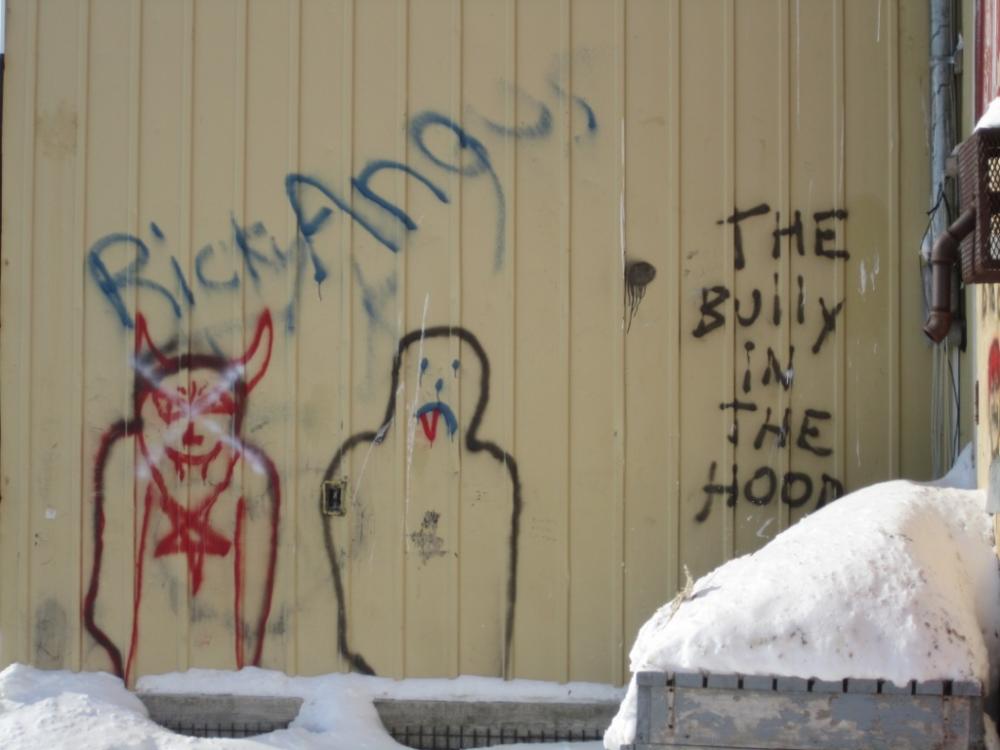
My final day in Igloolik is Easter Sunday and it’s the coldest day yet. No thermometer required for this assessment. I just take my hand out of my glove and see how long it takes the skin to chill down to the pain threshold: 30 seconds, by my watch.
I check out the two Easter church services, knowing I won’t see Kunuk at either one. But if it’s the traditional-modern dichotomy you’re after, there are few better places in Igloolik to observe it. At St. Stephen Roman Catholic, I eat frozen raw caribou. Up at St. Matthias Anglican, where Kunuk went until he was old enough to make his own choices, I turn to greet the man sitting next to me and find myself shaking hands with Avva the shaman.
Afterward, out on the ice, there are games and contests. There’s tug-of-war and a dog-sled race. Kids are demonstrating how to snowboard with a parasail and a group of young men are tossing a harpoon. I notice that Kunuk is participating in this last activity, and I go over to watch. They’re throwing the harpoon at what appears to be an impossibly small target: a disposable coffee cup set up on the snow 30 feet away. When Kunuk takes his turn, I snap a picture, thinking again of Qapirangajuq. The name means “to spear strangely,” a hunting term used in spearfishing, when you aim just off a target in order to hit it. Augustine Taqquraq suggested it as the film’s title after being asked for an Inuktitut word for “refraction.”
What my picture doesn’t capture is Kunuk’s throw. He hefts the steel harpoon. I see his weight shift, his body coil. And then it’s in the air. One glinting second, maybe two.
Bullseye.
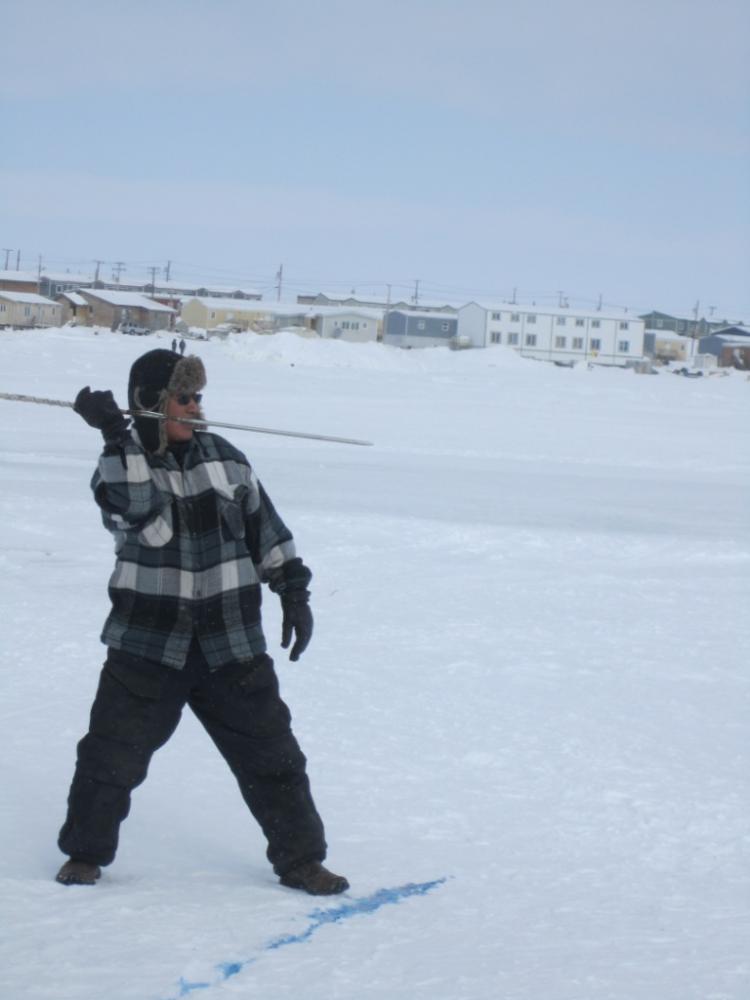
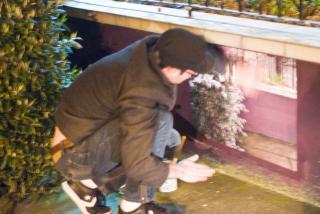
the man at work…
I’ve written several times in these pages about my friend Byron Dauncey, who is also the street artist known as Cameraman. I’m happy to do so again, as Byron was included in the CBC show “Cultural Secrets”, for which the CBC asked a whole range of people for suggestions. When they approached me, I took it to mean they wanted my idea of something/person/place that was culturally significant but not well known. Byron was my very first thought, although I hope that he does indeed become more widely known. He’s a secret that shouldn’t be secret.
The link to the CBC show is above. Here’s the clip of Cameraman by itself:
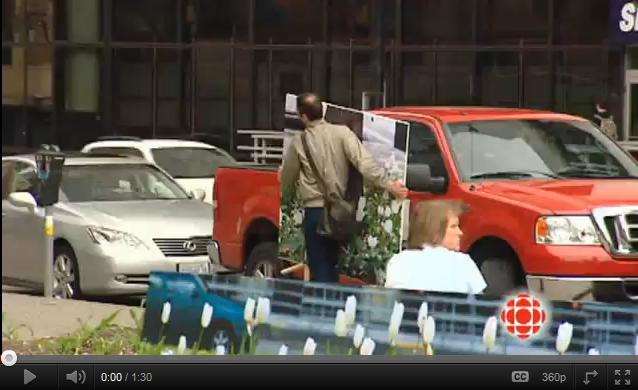
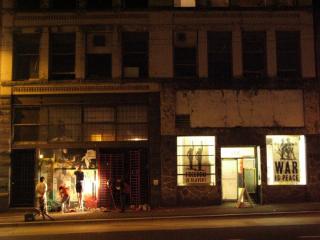 I’m mid-way through a piece for Vancouver Review on the topic of public art. As a result, I wouldn’t normally write and post anything on the topic because it might end up stealing from work to-be-published. But, with apologies to my kind and forbearing editors at VR, I’m going to make an exception here because we have an unusual and troubling art situation going down here in Vancouver: the City has threatened to shut down the Red Gate.
I’m mid-way through a piece for Vancouver Review on the topic of public art. As a result, I wouldn’t normally write and post anything on the topic because it might end up stealing from work to-be-published. But, with apologies to my kind and forbearing editors at VR, I’m going to make an exception here because we have an unusual and troubling art situation going down here in Vancouver: the City has threatened to shut down the Red Gate.
If you’re not familiar with it, the Red Gate is a non-profit space at 152 West Hastings Street opposite the Woodwards redevelopment. Run by Jim Carrico, it’s a kind of pure creative space (he calls it a Cultural Wildlife Refuge) where musicians and artists (street artists and others) hang out, create, and showcase their work. About three weeks ago the City gave Carrico 30 days to vacate. After a flood of protest, the City granted a 60 day extension. But the axe still hangs meaning the time has arrived for people to make themselves heard on the topic of why this closure should not happen and why Vancouverites should really care about the preservation of the Red Gate and institutions like it.
What’s driving this situation is development in the Downtown Eastside (DTES). As most Vancouverites know, the 100 block of West Hastings Street has already transformed with the completion of the new Woodward’s complex. And speaking as a 15 year tenant of the Dominion Building, at the corner of Hastings and Cambie half a block from the Red Gate, I feel qualified advancing the opinion that the Woodward’s development was sorely needed. 100 block West Hastings was never the worst block in the DTES, but when I moved my office into the area it was getting steadily worse. I saw crack use and drug sales almost every day, all the way up Hastings and into Victory Square. I remember bringing my kid to the office one weekend and having to jump in and stop him from picking up a hypodermic needle lying next to the cenotaph.
Having said that improvement was needed, it’s important to note that DTES “gentrification” was never the plan. I wrote an articlelast year about Army&Navy owner Jacqui Cohen and interviewed numerous prominent people about development of the DTES. Every one of them – including Larry Beezley, Jim Green, Bob Rennie and Cohen herself – stressed that “gentrification” was not the right approach. For the downtown, these powerful people seemed to agree, the “mixed use” model was better.
Why did they express this view? Because while “mixed use” plans try to preserve what’s best about a neighborhood through diversity, “gentrification” is what happens when you do development wrong. It means allowing lower income groups and artists to be displaced and, in the process, chasing out the established culture of a given area.
And make no mistake: there has been a distinct DTES culture. It’s about affordability, certainly. But it’s also about the sheer presence in numbers of artists, gallerists, filmmakers, writers, publishers, theater troupes, as well as a whole range of independent business people in technology, architecture, the law. What I’m describing is the kind of neighborhood on which every city vitally depends, those urban zones and spaces where small-scale creativity is expected, celebrated, and where it can thrive.
The Red Gate has been a critical part of that scene in the DTES and should be part of the neighborhood’s continued “mixed use”. I can give a personal example. I wrote a book recently, a novel called The Blue Light Project. Why? In large part due to the inspiration I found myself drawing from the DTES flourishing ecology of street art. I wasn’t a street artist. I was a total outsider. But I started my investigation at the Red Gate, where Jim Carrico arranged for me to meet the legendary Vancouver graff writer and street art historian Take5. Take was my window in, and through various introductions that followed, my own creative process was informed and stimulated. When I follow the causal chain, in other words, it goes back from my finished book through all of the people I met, through Take5 and the Red Gate, to the DTES itself.
And it seems to me that’s exactly how creativity is supposed to work in these most crucial urban zones. People are supposed to be positively infected by what’s going on around them, to be forced into an intellectual and aesthetic jostling together. Because it’s in those cultural mosh pits – at times anarchic, sure, but generating hugely productive creative energies – that new ideas are born.
New ideas. We want those. So we don’t want to stomp all over the places where they are cultivated. And that’s why people who care about this city, like those named above, may support mixed use development of the DTES, but not “gentrification” where you drive everybody out who isn’t a upmarket condo owner. That’s why, I’d reason, Gregor Robertson has reportedly said that he wants the Red Gate to stay open. Because people who care about the city recognize that gentrification is not just unfair, it kills a particular kind of urban creativity. And to do that would kill something essential to the entire city.
Let’s not let that happen. I encourage anyone who reads this post and agrees to write a letter of support to [email protected]. It’s not going to be easy. First thing Jim needs is an agreement from the building’s owner regarding long term occupancy, without which the building won’t qualify for the City’s Cultural Infrastructure Grant. But if enough noise is made, perhaps the pressure can be constructively applied in this case.
Timothy Taylor
]]>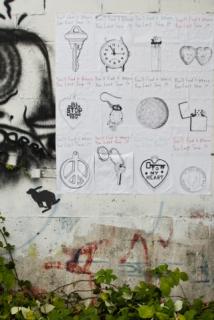
You’ll Find It Where You Last Saw It… artist unknown
Is a fictional character from my novel The Blue Light Projectcoming to life? A mystery is growing here.
I’ve just published a new novel about a street artist, the semi-fictional Rabbit. The book’s been getting amazing reviews. Banksy even tweeted about it recently. Not bad. In the book there are multiple photos of street art. Most of that work is by friends of mine, artists like JermIX, Cameraman, Rich S, A01 and legendary graffiti writer and train artist Take 5.
The piece pictured above, however, is by an unknown artist. It is based on a work described in the novel. Note the “Rabbit” tag on the piece at the bottom left corner. This is the subject of minor controversy in Vancouver as – since the book has come out – that tag has been appearing all over the place. Most often, it’s been going up near (or on) the work of Cameraman.
Like here, on one of Cameraman’s “Bring Back the Spring” posters.

Cameraman has grown kind of impatient about this. He’s teamed up with a documentary film crew who are running around interviewing everybody in the street art community in Vancouver.

And then this appeared in the alley behind the Monte Clark gallery:

That would be Cameraman. And yes, that would be a Rabbit trap. So things are apparently getting all serious. I just hope Rabbit – who is a character in a book, remember? – knows how to take care of himself in real life.
Please note that book is now available:
1) on AMAZON.ca
2) on AMAZON.com
3) or as an EBOOK right here